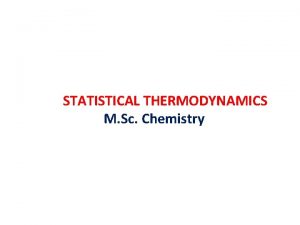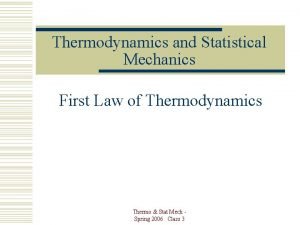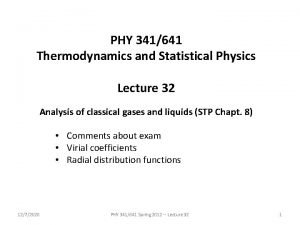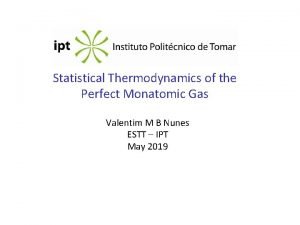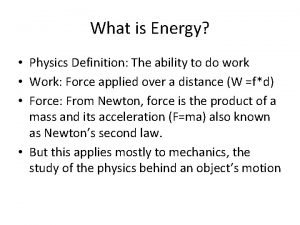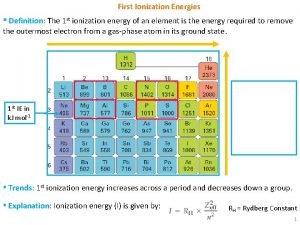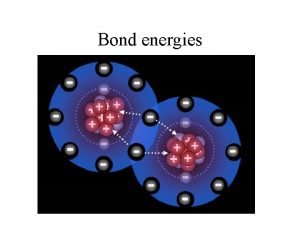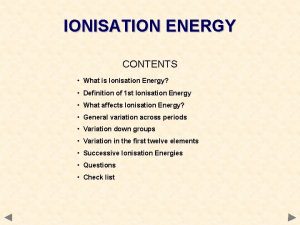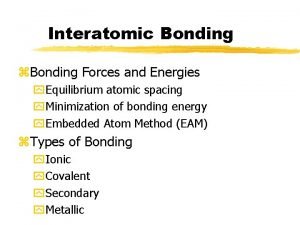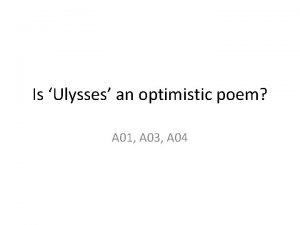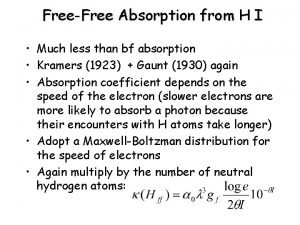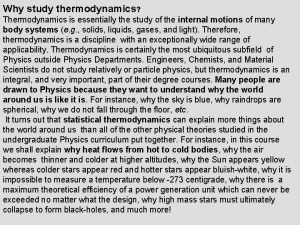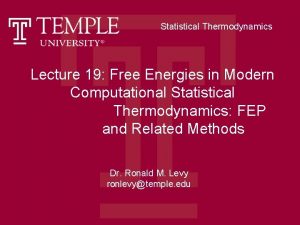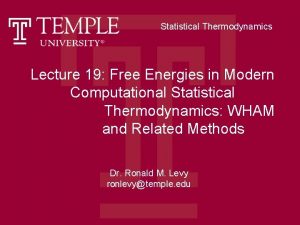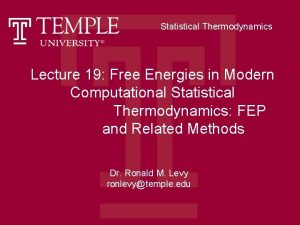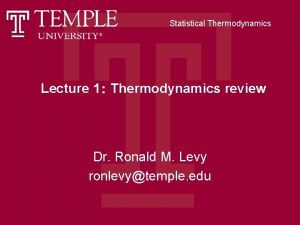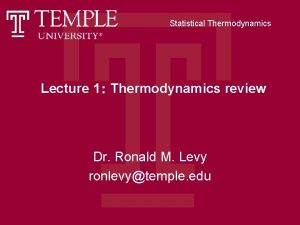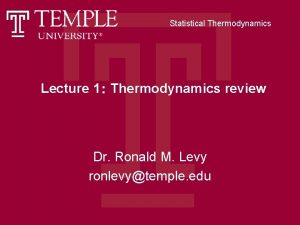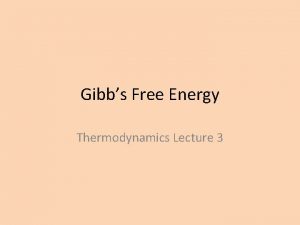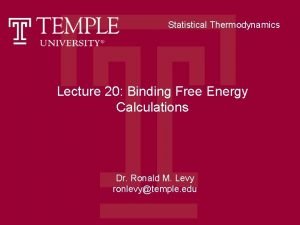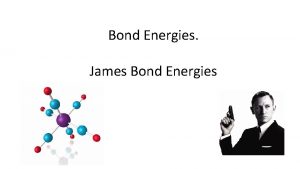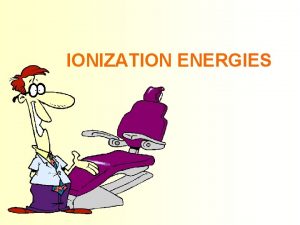Statistical Thermodynamics Lecture 19 Free Energies in Modern
























- Slides: 24

Statistical Thermodynamics Lecture 19: Free Energies in Modern Computational Statistical Thermodynamics: WHAM and Related Methods Dr. Ronald M. Levy ronlevy@temple. edu

Definitions • Canonical ensemble: l: system parameters and/or constraints focus on free energy changes that do not involve changing the number of particles, or their velocities, nor volume and temperature. Can work with configurational partition function: Or equival ently:

Example 1: Configurational Free Energy Changes l controls a conformational constraint (distance between two particles, dihedral angle, etc. ). Call the constrained property f(q): only conformations that satisfy the constraint f(q)=l (within a tolerance of dl) are allowed: Now: =1 So: integration of the constrained Z over all the possible constraints gives the unconstrained Z Free energy work for imposing the constraint:

Free energy work for imposing the constraint: it's basically an average of a delta function over the unconstrained ensemble. The delta function is non-zero only exactly at l. In actual numerical applications we would consider some finite interval Dl around a discrete set of li. Consider: Free energy for imposing constraint in interval Dl:

where: therefore: At the Dl->0 continuous limit: probability density

A(l) is the potential of mean force along l: The zero of the free energy is arbitrary: discrete l: continuous l:

Lesson #1: configurational free energies can be computed by counting – that is by collecting histograms or probability densities over unrestricted trajectories. Probably most used method. Not necessarily the most efficient. Achievable range of free energies is limited: N samples, N-1 in bin 1 and one sample in bin 2 For N=10, 000, DAmax ~ 5 kcal/mol at room temperature But in practice needs many more samples than this minimum to achieve sufficient precision

Method #2: Biased Sampling “umbrella” potential x Any thermodynamic observable can be “unbiased”:

Example: Unbiased probability for being near xi: Works only if biased potential depends only on x

How do we “merge” data from multiple biased simulations? distribution with biasing potential 1 w 1 (histogram probabilities p 1 i) w 2 distribution with biasing potential 2 (histogram probabilities p 2 i) w 3 distribution with biasing potential 3 (histogram probabilities p 3 i) distribution with biasing potential 1 (histogram probabilities p 2 i) distribution with biasing potential 3 Unbiased distribution p° 2 i Unbiased distribution p° 3 i w 1 (histogram probabilities p 1 i) distribution with biasing potential 2 Unbiased distribution p° 1 i ? w 2 Unbiased distribution p°i w 3 (histogram probabilities p 3 i) Any set of weights usi gives the right answer, but what is the best set of usi for a given finite sample size?

Multiple biased simulations to cover conformational space Biasing potentials ws(x) x

Weighted Histogram Analysis Method (WHAM): Optimal way of combining multiple sources of biased data Any set of weights usi gives the right answer, but what is the optimal (most accurate estimate) set of usi for a given finite sample size? Let's assume the unbiased probability is known, we can predict what would be the biased distribution with biased potential ws: biased probability free energy factor unbiased probability bias of bin i in simulation s

Likelihood of histogram at s given probabilities at s (multinomial distribution): In terms of unbiased probabilties: Joint likelihood of the histograms from all simulations:

Log likelihood: : Max likelihood principle: choose pi° that maximize the likelihood of the observed histograms. Need to express fs in terms of pi°:

Log likelihood: :

Thus (WHAM equations): Solved by iteration until convergence. Compare with single simulation case derived earlier: WHAM gives both probabilities (PMFs) and state free energies Ferrenberg & Swendsen (1989) Kumar, Kollman et al. (1992) Bartels & Karplus (1997) Gallicchio, Levy et al. (2005)

What about those optimal combining weights we talked about? Substituting. . . Therefore. . . WHAM optimal combining weights A simulation makes a large contribution at bin i if: 1. It provides many samples (large Ns) 2. Its bias is small compared to its free energy relative to the unbiased state.

WHAM: getting unbiased averages Computing the average of an observable that depends only on x is straightforward: From WHAM For a property that depends on some other coordinate y=y(q). Solve for p 0(x, y) – no bias on y – and then integrate out x: where:

Some WHAM Applications for PMFs PMF of Alanine Dipeptide Chekmarev, Ishida, & Levy (2004) J. Phys. Chem. B 108: 19487 -19495

2 D Potential. bias = temperature Gallicchio, Andrec, Felts & Levy (2005) J. Phys. Chem. B 109: 6722 -6731

b-hairpin peptide. Bias = temperature Gallicchio, Andrec, Felts & Levy (2005) J. Phys. Chem. B 109: 6722 -6731

The Concept of “WHAM weights” Consider the simple average of O(x): Let's sum over individual samples rather than bins and set: Where: WHAM weight of sample k. Measures likelihood of encountering xk in unbiased simulation.

WHAM weights example: probability distribution Apply previous averaging formula to p°i That is the unbiased probability at xi is the sum of the WHAM weights of the sample belonging to that bin.

Latest development: No binning WHAM = MBAR WHAM equations: substitute Get: Sum over samples MBAR equation Solved iteratively to convergence to get the f's Distributions obtained by binning the corresponding WHAM weights. Shirts & Chodera J. Chem. Phys. (2008). Tan, Gallicchio, Lapelosa, Levy JCTC (2012).
 Statistical thermodynamics in chemistry
Statistical thermodynamics in chemistry Thermodynamics and statistical mechanics
Thermodynamics and statistical mechanics Thermodynamics and statistical mechanics
Thermodynamics and statistical mechanics Statistical thermodynamics
Statistical thermodynamics 01:640:244 lecture notes - lecture 15: plat, idah, farad
01:640:244 lecture notes - lecture 15: plat, idah, farad What is physics energy
What is physics energy Ionization energy chart
Ionization energy chart Endothermic energy
Endothermic energy Negative image
Negative image Successive ionisation energies of calcium
Successive ionisation energies of calcium Bonding force and energy
Bonding force and energy European renewable energies federation
European renewable energies federation Reactants minus products
Reactants minus products We energies meter removal
We energies meter removal Four energies
Four energies Energies convencionals
Energies convencionals Gibbs free energy
Gibbs free energy Gibbs free energy spontaneous
Gibbs free energy spontaneous How to calculate gibbs free energy of a reaction
How to calculate gibbs free energy of a reaction Allocation map
Allocation map Helmholtz free energy and gibbs free energy
Helmholtz free energy and gibbs free energy Free hearts free foreheads
Free hearts free foreheads Plot of the story of an hour
Plot of the story of an hour Free free absorption
Free free absorption Pressure is state function or path function
Pressure is state function or path function
